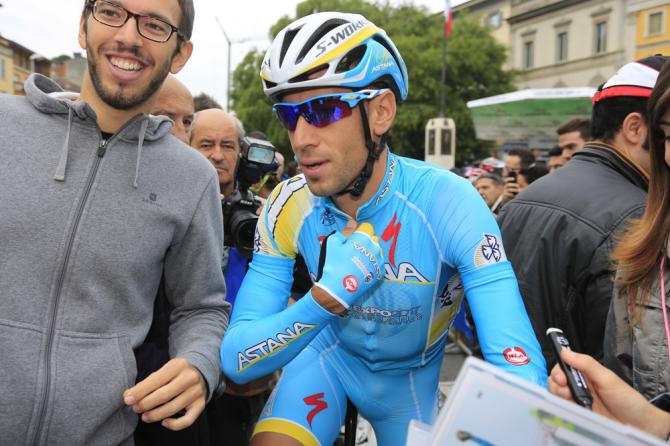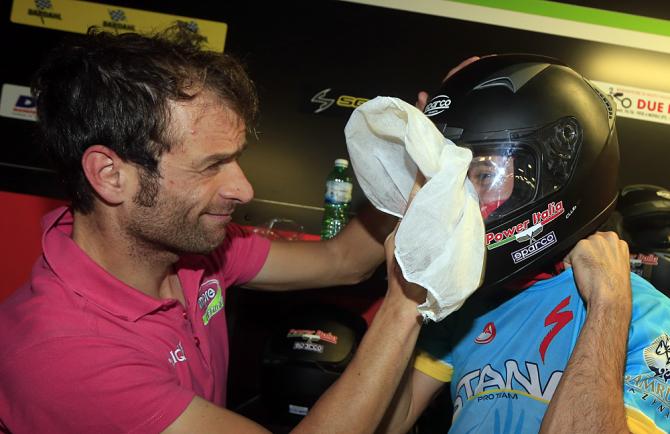2013 report card: Astana Pro Team
Nibali leads the line as Fuglsang and Kangert impress



Astana Pro Team
WorldTour Ranking: 5th
Win Count: 15
Top riders: Vincenzo Nibali (5th); Jakob Fuglsang (30th); Tanel Kangert (44th)
Grade: B+
2013 was a very good year for Vincenzo Nibali, and as a consequence it was a good one for Astana, who built the team around him following his switch from Liquigas last winter. The Sicilian duly lived up to his marquee billing and papered over some weaknesses elsewhere on the team with a season headlined by Giro d’Italia victory and punctuated by consistently strong performances throughout the campaign.
The early auguries were good for Nibali, as he repeated his 2012 victory at Tirreno-Adriatico, this time against arguably the strongest field in any stage race last season outside of the Tour de France. Undeterred by Chris Froome and Sky’s early dominance, Nibali turned the race on its head with a daring showing on a gripping day in the rain at Chieti.
Nibali signalled his Giro intentions by beating Bradley Wiggins at the Giro del Trentino, and by making an aggressive start to the corsa rosa and then time trialling his way into pink. Once he had broken Wiggins in week two, Nibali’s victory became something of a formality, and he finished with a flourish, claiming stage wins at Polsa and Tre Cime di Lavaredo.
After skipping the Tour, Nibali returned to duty at the Vuelta a España, and although well short of his Giro best, it took a most surprising display from 42-year-old Chris Horner to deny him the win. Nibali endured another near miss at the world championships on home roads in Florence, where Alejandro Valverde’s tight marking consigned him to a fourth place finish that was not a fair reward for his efforts.
A cursory glance at Astana’s win column for 2013 suggests a team totally reliant on Nibali, however, though manager Giuseppe Martinelli might perhaps argue that his was a team entirely devoted to its leader, and that was especially evident by the Astana guard’s sterling work at the Giro. Tanel Kangert, Fabio Aru and Valerio Agnoli certainly performed very impressively indeed for Nibali in May, particularly considering that the men slated as his key supports beforehand – Paolo Tiralongo and Fredrik Kessiakoff – were both short of their best at the time.
Indeed, Kangert proved to be one of the season's most consistent riders. The Estonian finished 13th at the Giro and 11th at the Vuelta even though his main task was to ride himself to a standstill for Nibali, and he also claimed a 6th place finish at the Tour de Suisse for good measure.
The latest race content, interviews, features, reviews and expert buying guides, direct to your inbox!
Jakob Fuglsang, meanwhile, was finally given the freedom to chase his own ambitions at the Tour de France, finishing 7th overall, and the Dane was also to the fore at the Dauphiné, where he came home in 4th place. Elsewhere, however, Maxim Iglinskiy and Enrico Gasparotto failed to repeat their Classics success of 2012, Andrea Guardini won just won race, and only eight of the team’s wins didn’t involve Nibali.
What to expect in 2014: After conquering Italy, Nibali’s sights are trained north of the Alps in 2014 as he returns to the Tour de France to take on Chris Froome. On his last appearance in 2012, Nibali was a rather distant best of the rest in the face of Sky’s dominance, reaching Paris in third behind Wiggins and Froome.
Two years on and approaching the peak of powers, however, Nibali ought to a very different proposition next July, when he lines up in Leeds as the greatest threat to Froome’s yellow jersey. He will certainly be buoyed by his experience at Tirreno-Adriatico, where his team’s guerrilla warfare offered a template for upsetting Sky that was replicated to good effect by Garmin-Sharp in the Pyrenees at the Tour.
In Astana, Nibali also has one of the very few teams that can rival Sky for strength-in-depth in a three-week race, and his phalanx of rather deluxe domestiques at Tour could include Jakob Fuglsang, new signings Michele Scarponi and Franco Pellizotti and the impressive Tanel Kangert, as well as his most trusted lieutenant, Valerio Agnoli. Impressive though his Giro win was, however, Nibali will need to be inventive if he is to deny Froome.
Milan-San Remo will be the focus of Nibali’s early season, and not only as a token of compensation to RCS Sport for his absence from the Giro. The addition of the Pompeiana before the Cipressa will certainly suit Nibali – who, lest it be forgotten, forced the winning break on the old course in 2011 and 2012 – although he will still need to find a way of shedding the more resilient fastmen on the Poggio.
The team was over-reliant on Nibali in 2013, and the Giro will provide an acid test of Astana’s 2014 transfer policy, which was based around securing riders who could ride for Nibali at the Tour while racking up wins elsewhere on the calendar. Scarponi and Fabio Aru line up as the protected riders, while Pellizotti should also be on hand. The young Aru gave notice of his potential on Tre Cime di Lavaredo last year while riding in support of Nibali, and he should thrive with a freer rein in 2014.
Indeed, while Nibali’s status is undisputed, it will be interesting to see how the hierarchy of stage racing talent below him is arranged when he isn’t in action. Scarponi, Pellizotti, Aru, Fuglsang and Kangert will all want to pick up WorldTour points when and where they can too, but there are only so many races on the calendar.
Elsewhere, Maxim Iglinskiy and Enrico Gasparotto will pose a dual threat at the Ardennes Classics. Neither man will be ranked among the favourites, but as 2012 proved, they can eke out a win when required.
Best signing: It’s difficult to laud the arrival of former Fuentes and Ferrari client Michele Scarponi or former biological passport case Franco Pellizotti, who remains on the sidelines until May as per MPCC regulations, although at least Astana’s adherence to the movement’s policies is a welcome step in the right direction, particularly considering some of the undesirables who have washed up at the team in the past.
Lieuwe Westra (Vacansoleil-DCM) is another important signing but perhaps the team’s most interesting acquisition was Mikel Landa, picked up from Euskaltel-Euskadi. There was no shortage of talent available following the Basque team’s disbandment, but Astana wasted no time in picking up Landa ahead of some more established names. 24 this month, Landa impressed as an amateur at Orbea and again as a neo-pro at the 2011 Vuelta a Burgos. With two Vueltas a España under his belt, Astana will hope the young climber develops still further in his new surroundings.
Biggest loss: None of the riders leaving Astana this off-season could really be described as weakening the team, but the most interesting departure is that of Andrey Kashechkin, in so much as his very presence on the team was something of a mystery. After his first spell at Astana finished with a positive test for blood doping in 2007, the Kazakh returned to the squad in late 2011, reportedly at the behest of commercial manager Aidar Makhmetov but against Alexandre Vinokourov’s wishes.
Vinokourov, of course, had been due to retire that year, but opted to stay on for another season before taking over as Astana’s general manager in 2013. The writing was on the wall last winter, when Kashechkin was temporarily suspended by Astana for allegedly failing to sign the team’s code of conduct, and his early abandon at this year’s Tour merely confirmed his fate. "A rider has to finish a race absolutely spent and not quit like that," Martinelli said. "That was the last straw. I don't know where he's going next year, but he won't be with Astana."
Man to watch: It’s a make or break year for Andrea Guardini, who endured a wretched debut campaign at Astana in 2013, claiming just one win, a stage at the Tour de Langkawi. The Italian sprinter’s pure speed is not in question – this is the man who out-stripped Mark Cavendish at Vedelago at the 2012 Giro, after all – but his inability to get himself into a winning position with any regularity means that his career stands at something of a crossroads. A stray turn and he risks going the way of men like Ivan Quaranta rather than matching the likes of Cavendish, Kittel et al.
Guardini’s searing turn of pace is a considerable weapon in his armoury, but he needs to develop a whole arsenal of supporting skills if he is to fulfil his considerable potential. Guardini’s endurance and climbing need work, but perhaps more pressingly, he needs to ditch the habit of losing wheels in chaotic finales. Jacopo Guarnieri will continue as Guardini’s guardian angel in the peloton, but Giuseppe Martinelli has gently warned that unless the sprinter gets some early results in Australia and Dubai, he will be riding the Tour de Langkawi instead of Paris-Nice, and won’t be considered for the Giro.

Barry Ryan was Head of Features at Cyclingnews. He has covered professional cycling since 2010, reporting from the Tour de France, Giro d’Italia and events from Argentina to Japan. His writing has appeared in The Independent, Procycling and Cycling Plus. He is the author of The Ascent: Sean Kelly, Stephen Roche and the Rise of Irish Cycling’s Golden Generation, published by Gill Books.